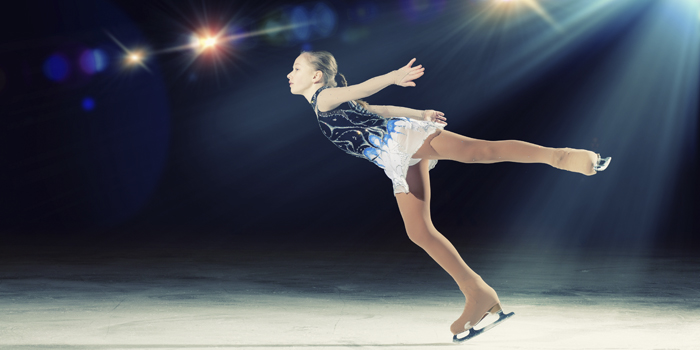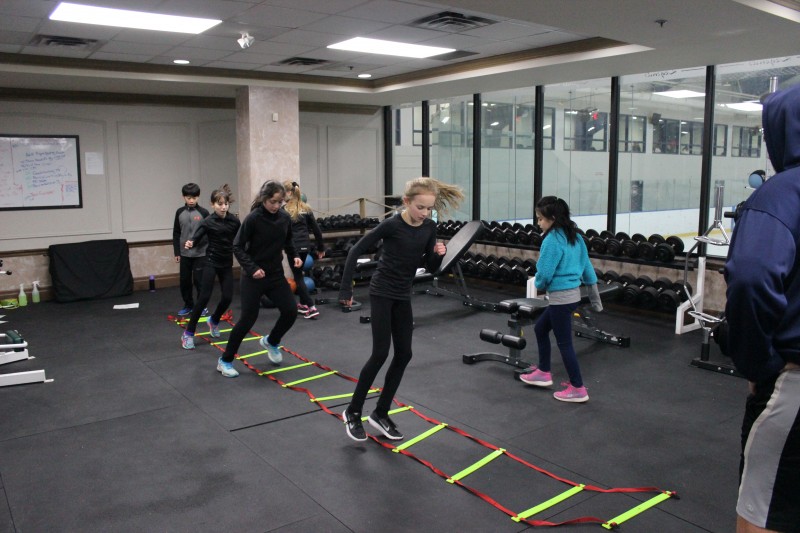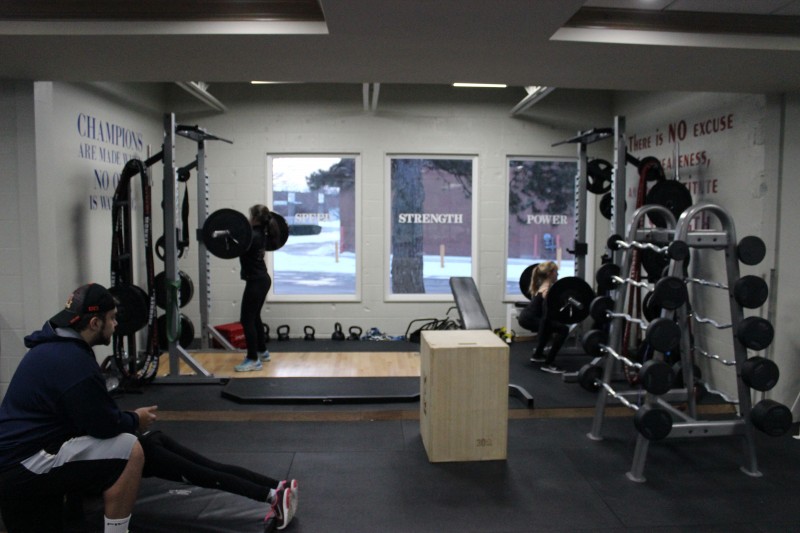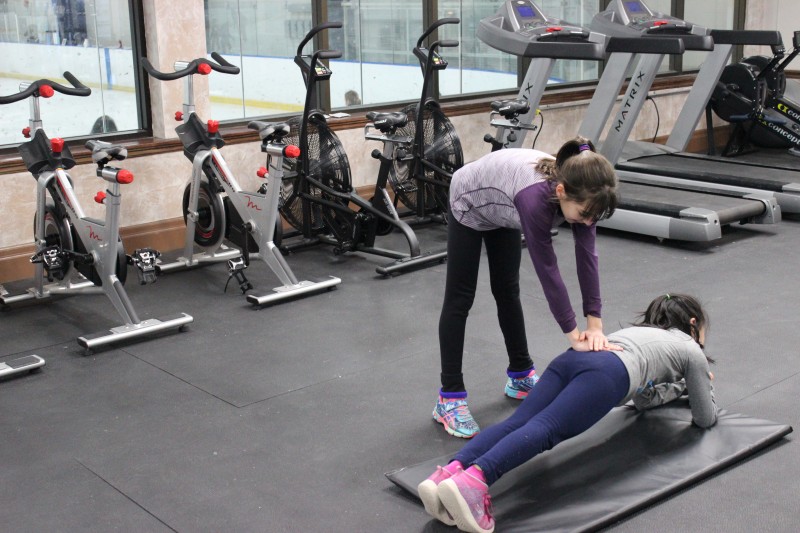
At Canadian Ice Academy, we operate a strong and talented figure skating program. As with hockey, we manage a high-performance athlete program for figure skating where the skaters attend school in the morning and then come to the arena to train for the remainder of the day. Our high-performance skaters are a young group (10 to 14 years old) but all have great promise, including the 2018 novice pairs Canadian champions. The skaters attend three dry land training sessions during the week: two fitness-building workouts and one stretch class on Fridays that is geared towards increasing flexibility to hit positions on the ice. Skaters usually compete every six to eight weeks and training volume is tapered individually based on their competition schedules. Similar to our hockey program, training groups are split into Bunny (beginner) and Wolf (intermediate), with none of them falling into the Bear (advanced) group yet.
Primer
We start every training session with ladder drills, sprints, or change-of-direction drills. The skaters don't get much exposure to acceleration training, so a small dose is extremely effective in priming their nervous systems for training.
Strength
Our strength training is geared towards increasing potential for power on jumps and building the eccentric strength to withstand the constant trauma of landing. While most people only see the beautiful landings on the ice, figure skaters perform dozens of jumps a day on dry land as well. Our kids begin with goblet squats, lunge variations, and trap bar deadlifts. They progress to front and back squats as their form develops. The most common body type among our skaters is a thinner frame with long levers, so anteriorly ends up being the best way to load them in a squat pattern. We are almost always utilizing a form of contrast training. If we do a front squat we pair it with a box jump; if we do a rear foot elevated lunge we pair it with a scissor jump. It is imperative that they come away with a direct translation to their sport.
Conditioning
Figure skaters need to be able to give a maximal effort in competition for anywhere from 1.5 to four minutes. This makes the sport aerobic in nature and thus presents the need for a fairly high level of conditioning. An especially unique part of the sport is that figure skaters need to perform while looking like they are enjoying themselves — facial expression and composure are judged during the program. This is certainly a feat of mental discipline, but as strength and conditioning coaches, we know the longer athletes can go without being fatigued the more mental strength they will be able to display (or the cliché, "fatigue makes cowards of us all"). Every dry land training session ends with an intense bout of conditioning. We only run once a week to allow their spines to recover from repetitive impact. The second session is usually a team relay on the rowing machines or sleds. Conditioning volume is dramatically reduced on the second session of the week for those who are competing that weekend.
Prehabilitation
Common injuries in figure skating include knee, ankle, hip, and disc-related injuries. We program joint-specific drills such as band TKE's and ankle circles to shore up weaknesses. Anterior pelvic tilt is common among figure skaters—they are constantly using momentum from the torso to propel jumps—so it must be addressed for spinal health and longevity. Training the abdominals to reset the spine is a goal in almost every training session. Our go-to exercises for this are ab wheel rollouts, hanging leg raises, and manually-resisted plank variations. So far we have seen substantial improvement in the posture of some of our skaters, and more importantly, have had no disc-related injuries this year. Muscle activation is another key piece: for some, there were glaring deficiencies in glute activation, for others, it was in recruiting the hip flexors. In both cases, Reflexive Performance Reset has been a great tool that gives immediate results, and with sustained focus often leads to a complete correction of the weakness. Band distraction and hanging are drills we rely on heavily to assist in decompressing our figure skater’s spines.
Regeneration
As the figure skaters are young and our group is almost entirely female, they recover well from training and usually aren't feeling very exhausted even by the end of the week. Nonetheless, our stretch session is an opportunity for them to down-regulate going into the weekend. We will address any restrictions they have by performing partner-assisted gymnastics-style stretches, getting them on the treatment table for an RPR reset, and usually getting some yoga done as well. We use this opportunity to practice visualization; figure skating as an individual judge-scored sport can be extremely stressful to some of the kids. Getting some relaxation going into the weekend is often much needed.
Sample Week
Monday
Primer:
- Agility Ladder (Crossovers, Single-Leg Jumps) — 5 x 2
Strength:
Superset, Four Sets:
- Front Squat — 8 reps
- High Box Jump — 5 reps
Circuit, Three Sets:
- Hanging Leg Raise — 10 reps
- Lateral Medicine Ball Slam — 5 reps each direction
- Band Good Morning —15 reps
Conditioning:
- As a team of four, row 3000 meters in under 16 minutes
Wednesday
Primer:
- Sprints — 10 meters
Strength:
- Hang Clean — 5 x 4
Superset, Three Sets:
- Decline Leg Raise — 10 reps
- Cable Row — 15 reps
- Suitcase Carry — 2 lengths
Conditioning:
- Bike or Rower — 40 seconds of max effort, 30 seconds of rest for 4 sets
Friday
Regeneration:
- Gymnastics Stretching Circuit — 20 minutes
- Reflexive Performance Reset — 5 minutes each
- Restorative Yoga and Visualization — 15 minutes
Header image credit: Sergey Nivens © 123rf.com
Jordan Guilford is a sports performance coach and a competitive powerlifter and strongman based out of Toronto, Ontario. He spent four years as a fitness instructor with the Canadian Armed Forces and is currently Fitness Director of Canadian Ice Academy, an elite training center for hockey players and figure skaters. He also owns Vej Athletics training and performance. You can contact Jordan via email at jordan@vejathletics.ca.












